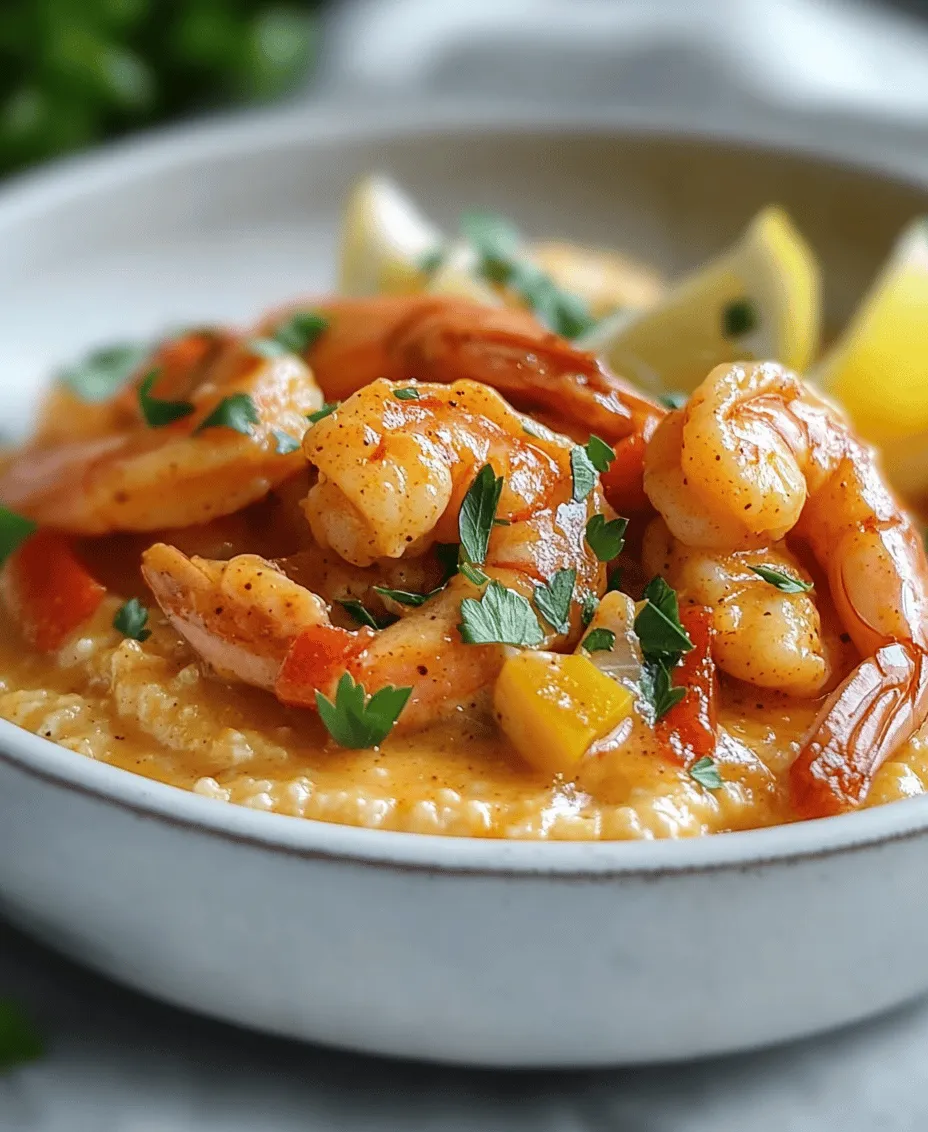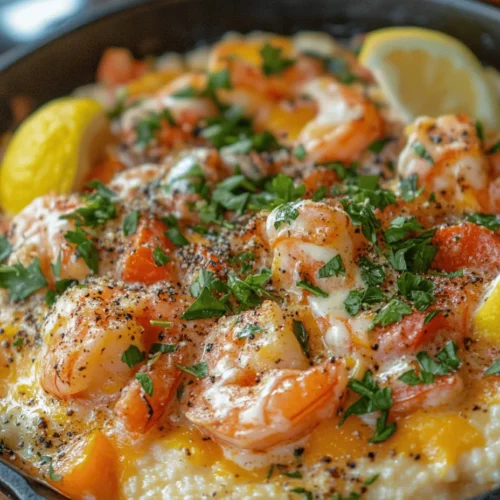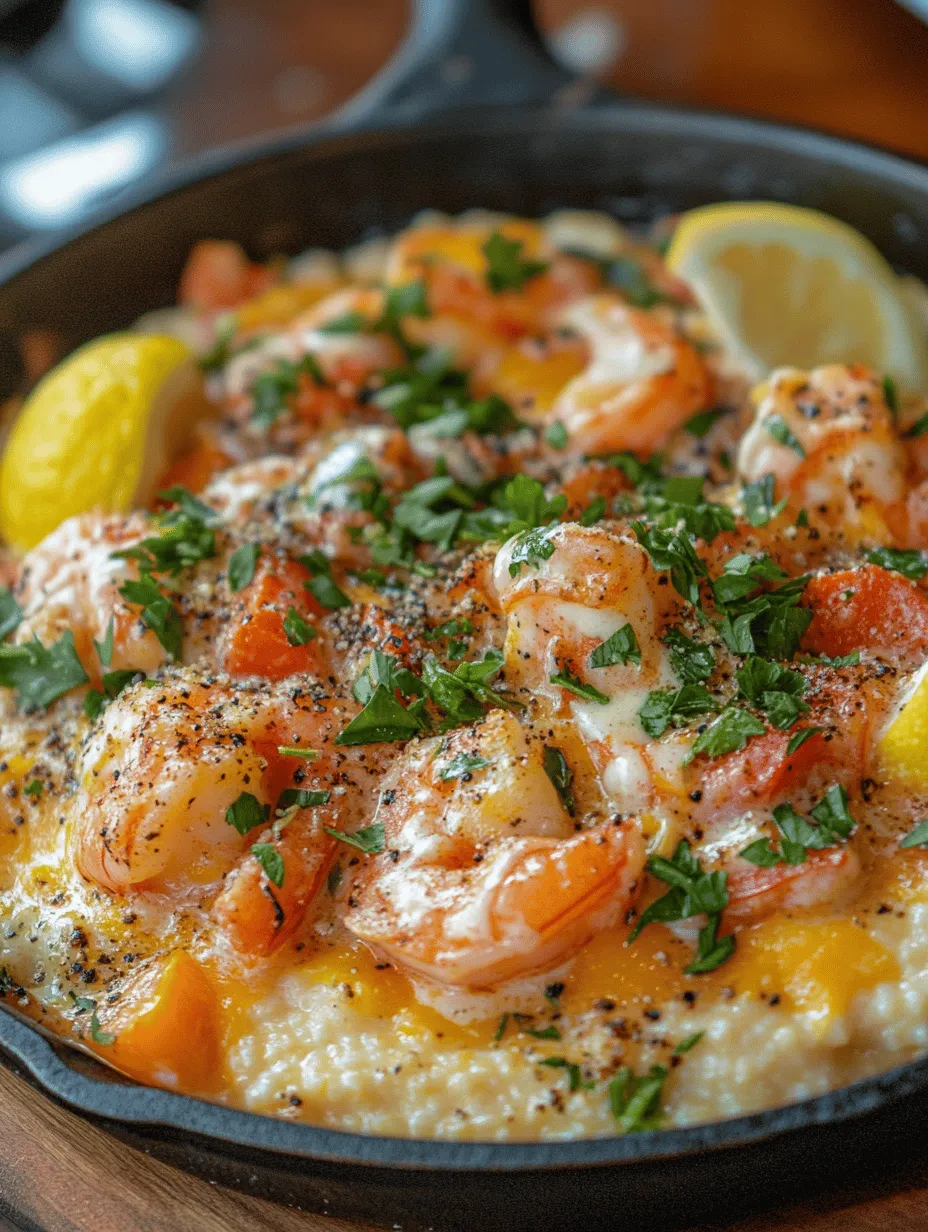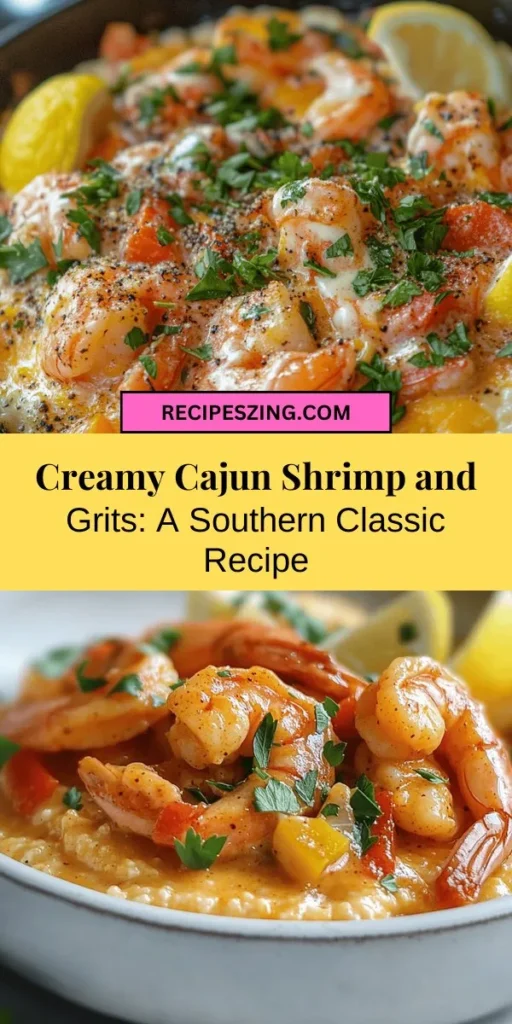Introduction
Creamy Cajun Shrimp and Grits is a dish that embodies the vibrant and bold flavors of Southern cooking. As a quintessential comfort food, it perfectly marries rich, creamy grits with spicy, succulent shrimp, creating a delightful experience for the taste buds. Originating from the coastal regions of the South, this dish has gained immense popularity not only for its satisfying flavors but also for its versatility in both casual and upscale dining settings.
The creamy texture of the grits serves as a soothing base that complements the zesty, well-seasoned shrimp. This harmonious balance between the mild and spicy elements offers a culinary experience that is both comforting and exciting. In recent years, Creamy Cajun Shrimp and Grits has made its way into homes and restaurants alike, becoming a staple on menus across the country. Whether enjoyed as a breakfast dish or a hearty dinner, it continues to captivate diners with its rich Southern heritage and delightful taste.
Understanding the Basis of Grits
To appreciate Creamy Cajun Shrimp and Grits fully, it’s essential to understand the foundation of the dish: grits. Grits, a staple in Southern cuisine, are made from ground corn, typically white or yellow. They have a long history in the American South, dating back to Native American tribes who prepared cornmeal to create a nourishing and versatile food source. Over the years, grits have evolved into a beloved comfort food, often served in various forms, from breakfast bowls to savory bases for dinner dishes like our featured recipe.
There are primarily two types of grits used in cooking: stone-ground and instant. Stone-ground grits are coarsely ground and offer a hearty, textured flavor. They take longer to cook but yield a richer taste and creaminess. On the other hand, instant grits are precooked and dried, making them quick to prepare, but they often lack the complexity that stone-ground varieties provide. When making Creamy Cajun Shrimp and Grits, opting for stone-ground grits is highly recommended to achieve that authentic Southern flavor profile.
In addition to their delightful taste, grits also come with nutritional benefits. They are rich in carbohydrates, providing a good source of energy. Grits are also low in fat and can be a gluten-free option for those with dietary restrictions. When prepared with wholesome ingredients like butter, cream, and cheese, they can be transformed into a luxurious side dish or a comforting meal.
Key Ingredients for Creamy Cajun Shrimp and Grits
Creating a dish as flavorful as Creamy Cajun Shrimp and Grits requires a thoughtful selection of ingredients. Each component plays a vital role in building the dish’s overall flavor and texture. Here’s an overview of the essential ingredients:
Stone-Ground Grits
The heart of this dish lies in the grits. Stone-ground grits provide a rich, creamy texture and a robust corn flavor that enhances the overall experience. They are typically cooked slowly, allowing the flavors to develop fully. This patience in preparation is what sets the dish apart.
Heavy Cream and Cheese
To achieve the ultimate creaminess, heavy cream is essential. It adds richness and depth to the grits, making them luxuriously smooth. Additionally, incorporating cheese, such as sharp cheddar or Parmesan, elevates the flavor, creating a savory combination that pairs beautifully with the shrimp.
Fresh Shrimp
The star of the dish is undoubtedly the shrimp. Using fresh, high-quality shrimp is crucial for achieving the best flavor. Opt for large shrimp, preferably wild-caught if possible, as they tend to have a sweeter and more robust taste. The shrimp are seasoned with a Cajun spice blend, which infuses them with a kick that complements the creamy grits perfectly.
Cajun Seasoning
A blend of spices that typically includes paprika, cayenne pepper, garlic powder, and onion powder, Cajun seasoning is essential for bringing a spicy and aromatic flavor to the shrimp. You can either purchase a pre-made mix or make your own to control the spice level according to your preference.
Ingredient Substitutions
While the traditional recipe for Creamy Cajun Shrimp and Grits is a winner, it’s important to consider dietary restrictions or preferences. For a lighter version, you can substitute heavy cream with half-and-half or a plant-based cream alternative. If you’re looking for a gluten-free option, ensure the grits are certified gluten-free. For those who prefer a vegetarian version, consider replacing shrimp with sautéed mushrooms or a mix of seasonal vegetables seasoned with Cajun spices.
Step-by-Step Guide to Preparing the Dish
Now that we have a comprehensive understanding of the key ingredients, let’s delve into the preparation of Creamy Cajun Shrimp and Grits. This step-by-step guide will ensure you achieve the perfect combination of creamy grits and flavorful shrimp.
Preparing the Grits
1. Cook the Grits: Start by bringing water or chicken broth to a boil in a medium-sized saucepan. For added flavor, consider using half water and half broth. Once boiling, gradually add the stone-ground grits while continuously whisking to prevent lumps.
2. Simmer: Reduce the heat to low, cover the saucepan, and let the grits simmer. Cooking time will vary depending on the type of grits used, but stone-ground grits typically take about 30-40 minutes to achieve a creamy consistency. Stir occasionally and add more liquid if needed to prevent sticking.
3. Add Cream and Cheese: Once the grits are cooked and have absorbed most of the liquid, remove them from heat. Stir in the heavy cream and cheese of your choice until fully incorporated. Season with salt and pepper to taste, and keep them warm while you prepare the shrimp.
Cooking the Cajun Shrimp
1. Prep the Shrimp: While the grits are cooking, prepare the shrimp by peeling and deveining them if not already done. Pat them dry with paper towels to remove excess moisture, which will help achieve a nice sear.
2. Season the Shrimp: In a bowl, toss the shrimp with Cajun seasoning, ensuring they are evenly coated. You can adjust the amount of seasoning according to your spice tolerance.
3. Sauté the Shrimp: In a large skillet over medium-high heat, add a tablespoon of oil or butter. Once hot, add the seasoned shrimp in a single layer. Cook for about 2-3 minutes on one side until they begin to turn pink and slightly charred.
4. Flip and Finish Cooking: Flip the shrimp and cook for an additional 1-2 minutes until they are fully cooked and opaque. Remove from heat, and if desired, add a splash of lemon juice or a sprinkle of chopped parsley for brightness.
Combining the Dish
Once both the grits and shrimp are prepared, it’s time to assemble your plate. Spoon a generous serving of creamy grits onto each plate and top with the beautifully sautéed Cajun shrimp. The result is a stunning dish that not only looks appealing but also delivers a burst of flavor with every bite.
This step-by-step guide provides the groundwork for crafting the perfect Creamy Cajun Shrimp and Grits. As you indulge in this Southern classic, savor the rich flavors and the warm, comforting textures that make this dish a beloved favorite across the globe.

Importance of Timing and Temperature in Cooking Shrimp
When preparing Cajun shrimp, perfect timing and temperature are crucial. Shrimp cook quickly, often within just a few minutes, and overcooking can lead to a rubbery texture that detracts from the dish’s overall appeal. The best practice is to cook shrimp until they are opaque and have curled into a C shape. This typically takes about 2-3 minutes per side, depending on their size.
To ensure even cooking, preheat your skillet until it is hot, but not smoking. A cast-iron or stainless-steel skillet is ideal for achieving that sought-after sear. Remember to work in batches if you have a lot of shrimp; overcrowding the pan can lower the temperature and result in steaming rather than searing. Once cooked, transfer the shrimp to a plate and cover them loosely with foil to keep warm while you prepare the sauce.
Achieving the Ideal Spice Level with Cajun Seasoning
Cajun seasoning is a blend that varies widely in heat and flavor based on the mix you choose. Common components include paprika for a mild sweetness, cayenne pepper for heat, garlic powder for depth, and onion powder for a savory note. When preparing your dish, start with a moderate amount of seasoning, approximately 1-2 tablespoons, and adjust according to your heat tolerance.
Remember, it’s easier to add more spice than it is to take it away, so it’s wise to taste as you go. If you find the heat level is too much, balancing it out can be achieved by adding a touch of cream or a sprinkle of sugar. The goal is to create a well-rounded flavor profile that enhances the shrimp and integrates seamlessly with the creamy grits.
Sautéing Aromatics and Creating the Sauce
The foundation of flavor in Cajun shrimp and grits lies in the aromatics. Begin by sautéing finely chopped onions and bell peppers in the same skillet you used for the shrimp. This step builds upon the fond left behind, infusing the dish with rich, savory undertones. Cook the vegetables until they are translucent and tender, which usually takes about 5-7 minutes.
Next, add minced garlic, cooking for an additional minute or so, just until fragrant. Garlic can burn quickly, so keep an eye on it. Once the aromatics are softened, introduce your Cajun seasoning to the mixture. This allows the spices to bloom, releasing their essential oils and intensifying their flavors.
To create a luscious sauce, deglaze the pan with a splash of chicken broth or white wine, scraping up any bits stuck to the bottom. This step not only enhances the flavor but also adds depth to the sauce. Finally, add the cooked shrimp back into the skillet, along with a splash of heavy cream to create a rich, velvety sauce that envelops the shrimp perfectly.
Role of Garlic and Vegetables in Enhancing Flavor
Garlic and vegetables are essential in building a complex flavor in your dish. Onions and bell peppers contribute sweetness and depth, while garlic adds an aromatic punch that elevates the overall profile. Each ingredient serves a purpose: the sweetness of the onions balances the heat of the Cajun spices, while the garlic provides a robust backbone.
Consider incorporating other vegetables like diced tomatoes or fresh spinach for added color and nutrition. These additions not only enhance the visual appeal of your dish but also boost its health benefits, providing essential vitamins, minerals, and fiber.
Tips for Thickening Sauces Without Losing Flavor
A creamy sauce is vital in Cajun shrimp and grits, and thickening it can be achieved without compromising the taste. One effective method is to let the sauce simmer on low heat, allowing it to reduce naturally. This concentrates flavors without the need for additional thickeners.
If you prefer a more immediate thickening effect, consider using a cornstarch slurry. Mix equal parts cornstarch and cold water, then gradually stir it into the simmering sauce. This method thickens without altering the flavor profile significantly. Alternatively, incorporating a bit of grated Parmesan cheese can enrich the sauce while also enhancing its creaminess.
Flavor Profile of Cajun Cuisine
Cajun cuisine is known for its vibrant, bold flavors that reflect the culture and history of Southern Louisiana. The hallmark of this cooking style is the use of aromatic spices that create an inviting warmth. At the heart of Cajun seasoning are paprika, cayenne pepper, garlic powder, onion powder, and black pepper, each contributing unique characteristics to the dish.
Paprika provides a sweet, smoky flavor, while cayenne adds a kick that can be adjusted to personal preference. Garlic powder and onion powder bring a savory depth that complements the richness of the cream and shrimp. When these components come together, they create a harmonious flavor profile that is both comforting and invigorating.
Cajun flavors also carry cultural significance, representing a blend of French, Spanish, and African culinary traditions. This fusion is evident in the use of ingredients like rice, seafood, and spices, which reflect the local resources and the diverse heritage of the region.
Serving Suggestions and Presentation
Presenting your Cajun shrimp and grits attractively can enhance the dining experience. Start by spooning a generous serving of creamy grits onto the plate, creating a base for the shrimp. Next, top the grits with the sautéed shrimp and sauce, allowing the vibrant colors to shine through.
For an elegant touch, consider garnishing your dish with freshly chopped parsley or green onions. A sprinkle of Cajun seasoning can also add a pop of color and hint at the flavors within. Serve with lemon wedges on the side, allowing guests to brighten the dish with a squeeze of fresh citrus.
Pair your Cajun shrimp and grits with traditional Southern sides for a complete meal. Cornbread is a classic accompaniment, providing a sweet contrast to the spiciness of the shrimp. Southern-style greens, such as collard greens or mustard greens, add a nutritious element and balance the richness of the dish.
Nutritional Information and Health Benefits
Understanding the nutritional value of your dish can enhance your cooking experience. A typical serving of Cajun shrimp and grits contains approximately 450-500 calories, depending on the portion sizes and specific ingredients used. Shrimp are low in calories and high in protein, making them a healthy choice. They are also a great source of selenium and vitamin B12, which support immune function and energy production.
The inclusion of vegetables, such as bell peppers and onions, adds fiber and essential vitamins, contributing to a balanced meal. While the creamy sauce provides indulgence, you can modify the recipe by using low-fat cream or substituting a portion with Greek yogurt for a lighter option.
When enjoying indulgent meals like Cajun shrimp and grits, it’s essential to balance your diet with healthy choices throughout the day. Focus on incorporating plenty of vegetables, whole grains, and lean proteins in your other meals to maintain a well-rounded nutritional profile.
Conclusion
Cajun shrimp and grits is more than just a dish; it’s a celebration of Southern culinary heritage that brings together bold flavors, comforting textures, and a sense of community. Its appeal lies in its versatility, allowing for adjustments in spice levels and ingredient choices to suit personal preferences. Whether you’re hosting a gathering or enjoying a quiet meal at home, this dish invites you to experience the rich, vibrant flavors of the South.
By making Cajun shrimp and grits at home, you not only learn the skills to create a classic Southern dish but also embrace the joy of cooking and sharing meals with loved ones. The process of preparing this dish, from sautéing the shrimp to creating the creamy sauce, is a rewarding experience that connects you to the heart of Southern cuisine. So gather your ingredients, invite friends or family to join you, and embark on a culinary journey that celebrates the essence of Cajun cooking.



